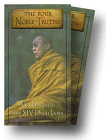 ®
®Videos by Subject
Understanding Buddhism
 Robert
Thurman, et
al.
Robert
Thurman, et
al.The Four Noble Truths: His Holiness The XIV Dalai Lama
(1996)
Availability: Usually ships within 24 hours.
![]()
Rated: NR
Edition Details:
• NTSC format (for use in US and
Canada only)
• Color, NTSC
• Number of tapes: 4
• ASIN: 6304316739
Amazon.com
In his first sermon at Deer Park, the historical Buddha spoke of the
Four Noble Truths of sentient existence:
1. The existence of suffering, or dukkha
2. The cause of suffering (karma)
3. The cessation of suffering
4. The Path that leads to the cessation of suffering
This set of four videos collects a series of lectures on the Four Noble Truths given by His Holiness the XIV Dalai Lama in 1997 in England. The lectures were a landmark event, bringing together for the first time in the West a nonsectarian Buddhist and lay audience for over six hours of emotional and intellectually challenging engagement with these central teachings of the Buddhist canon. The impressive intellect and scholarship of His Holiness is everywhere evident in these tapes as he traverses the expansive body of Buddhist scriptures and commentaries. One also catches glimpses of his mischievous sense of humor and, of course, his inspiring compassion.
The first tape is a framework for the discussion of the Four Truths. His Holiness discusses the importance of developing a critical insight toward one's perceptions of reality, and he emphasizes the value of the Three Jewels (Buddha, Dharma, and Sangha) in finding the way to this insight. Though he begins in English, as he gets into the finer points of Tibetan philosophy he turns to his native language and speaks through a translator. The tape concludes in a lighthearted mode with a question-and-answer period, again in English, in which he giggles over the Western interest in finding the "quickest, cheapest, and most efficient" way to enlightenment.
The second tape addresses the First of the Truths, of dukkha, or suffering. Here His Holiness searches for the roots of this suffering in an understanding of cosmology, both among Buddhist writings and among the work of contemporary physicists, but ultimately he points to our human ignorance of the fleeting nature of pleasurable experience as the root cause.
Tape 3 opens with an analysis of the causes of suffering (the law of karma). He begins to set out the Buddhist path, which, he says, must always be grounded in the aspiration for "freedom from samsara"--life amid the world of afflictive emotions. In the most impassioned moment of the hours of lectures, His Holiness uses his surprisingly deft English to explain how our emotions are the true "enemy" and destroyer of all of our happiness and health. If you believe, he argues, that one can do something about one's feelings of greed, anger, etc., then one should dedicate oneself to study and mental training to root out the afflictive emotions and foster the positive emotions. The end of tape 3 briefly addresses the Third Truth, of the cessation of suffering.
Finally, tape 4, which is peppered with references to classical Buddhist texts, takes up the Path (The Eight-Fold Path, as it is usually called) to "direct, intuitive realization of emptiness." At the root of this path, His Holiness says that one most foster bodhichitta, the altruistic desire to attain enlightenment for oneself so that one may help others. He recommends that one devote oneself, above all else, to seeing oneself as interconnected with all other beings. To stay on the Path, one must be devoted to single-point meditation and analytical meditation. And one must be determined. Enlightenment may, he admits, take eons.
One curiosity of the videos is the cameraperson's roving eye. Frequently,
the picture will settle on a rapt or amused audience member. On a couple of
occasions, the faces in the audience are famous: John Cleese and various British
TV personalities. Each of the four videos also includes a brief introduction by
Tibetan Buddhism scholar Robert Thurman, who contextualizes the lectures within
the many Buddhist traditions. --Patrick O'Kelley
Click
here to purchase from Amazon.com
